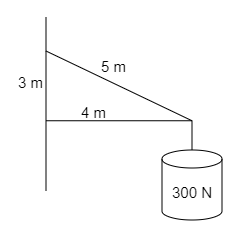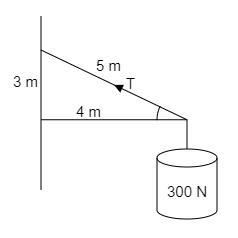
The horizontal and vertical components of the force exerted on the beam at the wall

(A) horizontal component is $500\,N$ towards left and vertical component $75\,N$ downwards
(B) horizontal component is $500\,N$ towards right and vertical component $75\,N$ upwards
(C) horizontal component is $625\,N$ towards left and vertical component $150\,N$ upwards
(D) horizontal component is $625\,N$ towards right and vertical component $150\,N$ downwards
Answer
218.1k+ views
Hint: The horizontal and vertical components of the force exerted on the beam at the wall can be determined by tension on the rope. To find the tension of the rope, the angle should be determined, then by using the angle value the tension is determined, then the horizontal and vertical force is determined by using the tension value.
Complete step by step solution:

From the diagram given in the question,
$\sin \theta = \dfrac{3}{5}$
By dividing the terms in the above equation, then
$\sin \theta = 0.6$
By rearranging the terms in the above equation, then
$\theta = {\sin ^{ - 1}}0.6$
Then the angle value is, $\theta = {37^ \circ }$
Now, the tension equation for the given diagram is written as,
$4T \times \sin {37^ \circ } = \left( {150 \times 2} \right) + \left( {300 \times 4} \right)\,................\left( 1 \right)$
At the point of the weight hangs, the vertical tension of the rope is given as $4T\sin {37^ \circ }$
The above equation (1) is the vertical force component equation, the RHS of the equation shows the equation of weight.
By multiplying the terms in the equation (1), then the above equation is written as,
$4T \times \sin {37^ \circ } = 300 + 1200$
The value of the term $\sin {37^ \circ } = 0.6$, then the above equation is written as,
$4T \times 0.6 = 300 + 1200$
By multiplying the terms in the above equation, then the above equation is written as,
$2.4 \times T = 300 + 1200$
By adding the terms in the above equation, then the above equation is written as,
$2.4 \times T = 1500$
By rearranging the terms in the above equation, then the above equation is written as,
$T = \dfrac{{1500}}{{2.4}}$
By dividing the terms in the above equation, then the above equation is written as,
$T = 625\,N$
The horizontal force is given by,
${F_H} = T\cos {37^ \circ }$
By substituting the tension value in the above equation and also the value of the $\cos {37^ \circ } = 0.79863551$, then the above equation is written as,
${F_H} = 625 \times 0.79863551$
By multiplying the terms in the above equation, then the above equation is written as,
${F_H} = 500\,N$
Now, the vertical force is given by,
${F_V} + T\sin {37^ \circ } = 150 + 300$
By substituting the tension value in the above equation and also the value of the $\sin {37^ \circ } = 0.6$, then the above equation is written as,
${F_V} + 625 \times 0.6 = 150 + 300$
By adding the terms in the above equation, then the above equation is written as,
${F_V} + 625 \times 0.6 = 450$
By rearranging the terms in the above equation, then the above equation is written as,
${F_V} = 450 - \left( {625 \times 0.6} \right)$
By dividing the terms in the above equation, then the above equation is written as,
${F_V} = 450 - 375$
By subtracting the terms in the above equation, then the above equation is written as,
${F_V} = 75\,N$
Hence, the option (A) is the correct answer.
Note: The force of the horizontal component is acting on the left side because the tension of the rope pushes the rod towards the left side. And then the weight of the component pulls the rod downwards. The tension of the rope is used to determine the force.
Complete step by step solution:

From the diagram given in the question,
$\sin \theta = \dfrac{3}{5}$
By dividing the terms in the above equation, then
$\sin \theta = 0.6$
By rearranging the terms in the above equation, then
$\theta = {\sin ^{ - 1}}0.6$
Then the angle value is, $\theta = {37^ \circ }$
Now, the tension equation for the given diagram is written as,
$4T \times \sin {37^ \circ } = \left( {150 \times 2} \right) + \left( {300 \times 4} \right)\,................\left( 1 \right)$
At the point of the weight hangs, the vertical tension of the rope is given as $4T\sin {37^ \circ }$
The above equation (1) is the vertical force component equation, the RHS of the equation shows the equation of weight.
By multiplying the terms in the equation (1), then the above equation is written as,
$4T \times \sin {37^ \circ } = 300 + 1200$
The value of the term $\sin {37^ \circ } = 0.6$, then the above equation is written as,
$4T \times 0.6 = 300 + 1200$
By multiplying the terms in the above equation, then the above equation is written as,
$2.4 \times T = 300 + 1200$
By adding the terms in the above equation, then the above equation is written as,
$2.4 \times T = 1500$
By rearranging the terms in the above equation, then the above equation is written as,
$T = \dfrac{{1500}}{{2.4}}$
By dividing the terms in the above equation, then the above equation is written as,
$T = 625\,N$
The horizontal force is given by,
${F_H} = T\cos {37^ \circ }$
By substituting the tension value in the above equation and also the value of the $\cos {37^ \circ } = 0.79863551$, then the above equation is written as,
${F_H} = 625 \times 0.79863551$
By multiplying the terms in the above equation, then the above equation is written as,
${F_H} = 500\,N$
Now, the vertical force is given by,
${F_V} + T\sin {37^ \circ } = 150 + 300$
By substituting the tension value in the above equation and also the value of the $\sin {37^ \circ } = 0.6$, then the above equation is written as,
${F_V} + 625 \times 0.6 = 150 + 300$
By adding the terms in the above equation, then the above equation is written as,
${F_V} + 625 \times 0.6 = 450$
By rearranging the terms in the above equation, then the above equation is written as,
${F_V} = 450 - \left( {625 \times 0.6} \right)$
By dividing the terms in the above equation, then the above equation is written as,
${F_V} = 450 - 375$
By subtracting the terms in the above equation, then the above equation is written as,
${F_V} = 75\,N$
Hence, the option (A) is the correct answer.
Note: The force of the horizontal component is acting on the left side because the tension of the rope pushes the rod towards the left side. And then the weight of the component pulls the rod downwards. The tension of the rope is used to determine the force.
Recently Updated Pages
Arithmetic, Geometric & Harmonic Progressions Explained

Cartesian Form of Vector Explained: Formula, Examples & Uses

Apparent Frequency Explained: Formula, Uses & Examples

Calorimetry: Definition, Principles & Calculations

Centrifugal Force Explained: Definition, Formula & Examples

Charge in a Magnetic Field: Definition, Formula & Examples

Trending doubts
JEE Main 2026: Application Form Open, Exam Dates, Syllabus, Eligibility & Question Papers

Derivation of Equation of Trajectory Explained for Students

Hybridisation in Chemistry – Concept, Types & Applications

Understanding the Angle of Deviation in a Prism

Understanding Collisions: Types and Examples for Students

How to Convert a Galvanometer into an Ammeter or Voltmeter

Other Pages
JEE Advanced Marks vs Ranks 2025: Understanding Category-wise Qualifying Marks and Previous Year Cut-offs

Understanding Atomic Structure for Beginners

Ideal and Non-Ideal Solutions Explained for Class 12 Chemistry

Degree of Dissociation: Meaning, Formula, Calculation & Uses

Understanding Electromagnetic Waves and Their Importance

Understanding the Electric Field of a Uniformly Charged Ring




